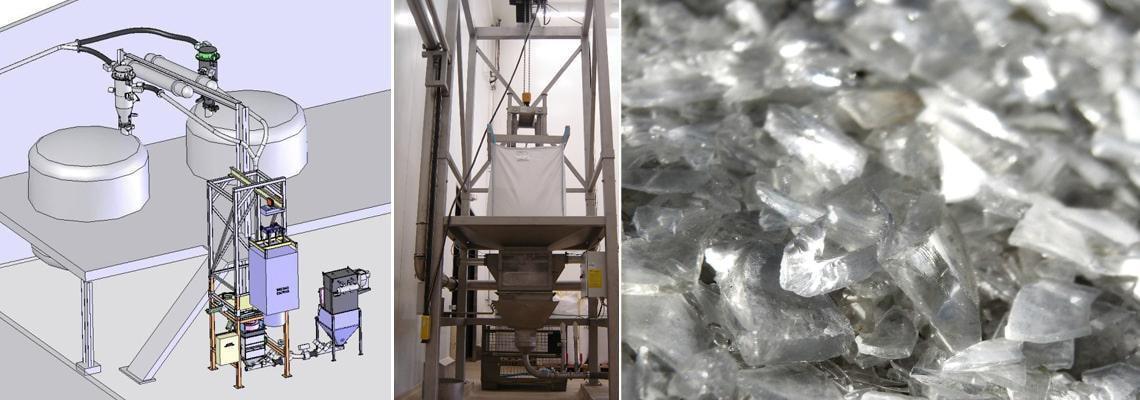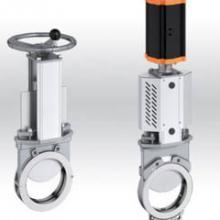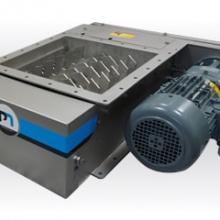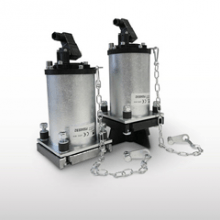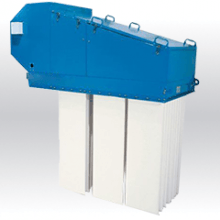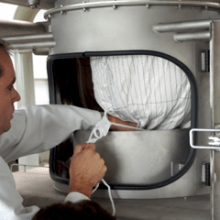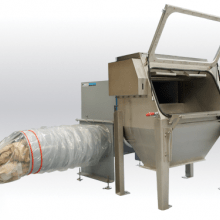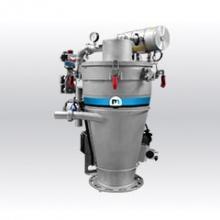Processed powders:
Maleic Anhydride: Bulk Density 1,310 KG/M³
Epo Kukdo, Der 671 Bulk Density 1,180 KG/M³
Resin and gel coat manufacturing
The client is a world leader in the production of structural resins for the building, automotive, water sports and leisure industries. The company is also a major player in the markets for decorative and glaze paints, coatings, inks, graphic arts and adhesives.
The customer requested a production line for controlled feeding of their reactor at a rate of 4 tons/hour with high density raw materials that are capable of being strongly solidified in mass. All equipment must comply with ATEX directives for explosion protection.
Sack and bulk bag unloading station
Palamatic Process supplied our EasyFlow® EF01 bulk bag emptying station. This industrial solution allows the super sack to be installed with an electric hoist and a handling cross on the dispensing platform with a sealing skirt. The operator opens the unlacing cabinet and unties the bulk bag discharge spout knot to allow the material to flow via gravity. Six large pneumatic cylinders apply pressure to the lower and lateral parts of the bulk bag to facilitate the flow of the bulk materials and break up any potential bridging or rat-holing issues.
A lump breaker is positioned under the funnel, below the unlacing cabinet, to break up any smaller agglomerates that may have formed while in bulk bag storage. This lump crusher is provided with eight blades mounted asymmetrically on a very high-strength drive shaft. This shaft is driven by a gear motor with high torque, which reduces lumps to a size acceptable for pneumatic conveying (air-to-material mix ratio).
Other equipment that is a part of this installation is a bag opening station, the Sacktip® S model. This bag dump station is installed to unpack 50 lbs. bags with an operator opening an access door (supported by gas springs cylinders) and places the bag on the safety tray. He then pushes the bag onto the safety grid inside the station, which is above the powder discharge hopper. Once loaded into the sack tip tray, the operator manually opens the bag and empties it. The 200-liter powder discharge hopper on the bag emptying station is provided with two pneumatic hammers and four vibrators that help with bulk material flow and full evacuation through the discharge outlet.
A dust extraction system is integrated into the bag dump station and a reverse pulse jet cleaning system is installed on each cartridge. A chute fitted with a polyethylene bag allows the empty sacks to be evacuated, avoiding the spreading of dust once the operation is completed.
Powder conveying
In order to convey the bulk materials from either depacking station to one of the two reactors, a set of two switches, which are controlled by the operator from the control panel, is mounted on the conveying pipes.
The raw materials are pumped through the VFlow® 05 dense phase vacuumed pneumatic transfer system. The conveying rate of the raw materials is 6,100 liters/hour. The pneumaticvacuum conveying system works on the principle of the high vacuum depressor. The receiving cyclofilter connected to the reactor, cyclones the discharged powder and thus carries out the air/product separation. The highly efficient filter integrated into the cyclone ensures the final separation of the air and the protection of the vacuum pump (suction unit). A compressed air cleaning system allows the filter to be cleaned at each change-over.
The material transfer from either unloading station to one of the two reactors uses a set of two switches, which are controlled by the operator from the control panel, and is mounted on the pneumatic conveying pipes.
The raw materials are pumped through the VFlow® 05 dense phase vacuumed pneumatic transfer system. The conveying rate of the raw materials is 6,100 liters/hour. The pneumatic vacuum conveying system works on the principle of the high vacuum depressor. The receiving cyclo-filter connected to the reactor, cyclones the discharged powder and provides the necessary air/product separation function. The highly efficient filter integrated into the cyclone ensures the final separation of the air and the protection of the vacuum pump (suction unit). A compressed air cleaning system allows the filter to be cleaned at each change-over.
Loading of reactors
The VFlow® 05 conveying cyclones are equipped with a slide valve that allows the entire line to be evacuated and the supply of bulk materials to be cut off on demand. A capacitive level sensor is used to detect the presence of the bulk material once the cyclone is full and stops the material transfer by controlling the slide gate valve.
A volume nozzle, equivalent to that of the cyclone, forms a chamber between the reactor valve and the cyclone valve. As soon as the probe is covered, the cyclone inlet valve closes, the bottom valve opens and a high nitrogen pressure is sent through the filter to force the downflow into the reactor and avoid pressure build-up in the cyclone.














